1/48th TsKB12-bisBy Emilio Diaz |
1/48th TsKB12-bisBy Emilio Diaz |
Nikolai Pollikarpov's vision of the future V.V.S. main fighter was ready to take flight in the winter of 1933-34. The TsKB was the most advanced fighter in the world at this time. The Central Design Bureau prototypes were to become the most innovative of Soviet designs of the 1930's. Two prototypes were built to fully explore the handling of these new radical looking aircraft. The maiden flight of the first TsKB-12 happened on the 30th of December 1933 with Valeri F. Chkalov at the controls. It was powered by the M-22, a Soviet-built version of the Bristol Jupiter VI, equipped with a two bladed prop. The second prototype was built with an American Wright-Cyclone SRG-1820-F2 and a Hamilton-Standard propeller and a N.A.C.A. designed cowling. Flying for the first time during early January 1934 with V. Stepanchonok as the test pilot. Both aircraft were fitted temporarily with fixed ski landing gear, because of the harsh winter conditions, completed their flight trials successfully by April of 1934.

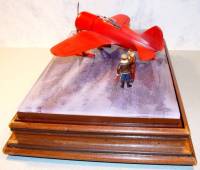 The
design was accepted for production as the I-16 and the "Ishachok"
(little donkey) went on to become the backbone of the Red Air Force. The aircraft's
baptism of fire began with the Spanish and the Chinese as a soldier of fortune.
It later fought in the border wars with the Japanese over the disputed grasslands
of Mongolia. The I-16 was heavily committed to every major theater of the Great
Patriotic War: South from the vast steppes of the Ukraine, north to the snow
drift covered forests of Finland and east to the gates of Moscow. Flying from
all the combat fronts of the great empire, I-16's fought till replaced with
the next generation of Soviet fighters. She will always be remembered as a stout
defender of the Motherland.
The
design was accepted for production as the I-16 and the "Ishachok"
(little donkey) went on to become the backbone of the Red Air Force. The aircraft's
baptism of fire began with the Spanish and the Chinese as a soldier of fortune.
It later fought in the border wars with the Japanese over the disputed grasslands
of Mongolia. The I-16 was heavily committed to every major theater of the Great
Patriotic War: South from the vast steppes of the Ukraine, north to the snow
drift covered forests of Finland and east to the gates of Moscow. Flying from
all the combat fronts of the great empire, I-16's fought till replaced with
the next generation of Soviet fighters. She will always be remembered as a stout
defender of the Motherland.
The inspiration for this model came from a H.R. Models 1/72nd TsKB-bis as featured in the gallery from this web site. Uwe Borchert built this beautiful little model and I just had to add one to my collection.
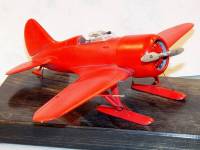
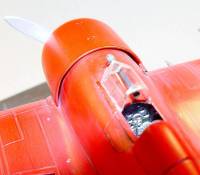 I
decided to model the same prototype, but in 1/48th, by using the old Airmodels/WK
Models solid resin kit as a starting point. I had started this kit back in the
late 1980's and put it away till I could get some decent references. I just
bought Red Star Vol. # 3 and Soviet Air Force Colors 1941-45, so it was time
to bring the old kit out.
I
decided to model the same prototype, but in 1/48th, by using the old Airmodels/WK
Models solid resin kit as a starting point. I had started this kit back in the
late 1980's and put it away till I could get some decent references. I just
bought Red Star Vol. # 3 and Soviet Air Force Colors 1941-45, so it was time
to bring the old kit out.
First, I detailed the cockpit using plastic rod, sheet, stretched sprue, H.O. train fittings and the modified seat from Academy's F4U-4b. The only photo etched parts I used were the seat belts for the seat. Having a cowling left over from a Corsair conversion, I modified these parts using 1/72nd plans that came from the French book, "Les avions de chasse Polkarpov". Having enlarged these plans to 1/48th, I compared the parts to the plans and marked the places to cut. I then modified the fuselage, to accept the new cowling, by cutting off the nose of the W/K model and sanded the fuselage till the old cowling taper was removed. I then fitted the cowling to the fuselage and removed the material for the wing root recess with a cordless Dremel tool set at slow speed so as not to melt the plastic.
Next I filled in the wheel bays, using Micro Ballons with super glue and scribed in the landing gear covers. In order to scratch build the ski landing gear, I had a front and side profile photos of the aircraft with the skis attached, I enlarged these photos till the fuselage matched the kit length. This then gave me the proper dimensions of the landing skis; I made these using plastic airfoil shaped struts and balsa stock for the ski bodies. The skis where sanded to profile and sealed with several coats of primer. I added these to the model by first drilling the attachment points and then drilling and pinning the landing skis struts. These were then trial fitted to the model to make sure everything lined up.
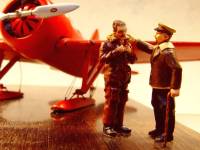
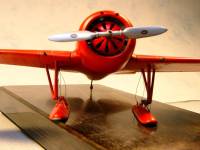 I
removed all the external wing rib detail, which is wrong, being a combination
of all I-16 types. I then added the correct rib detail to the wings and tail
units by painting. This included removing the ailerons. I began by masking off
all the rib and panel detail in negative with masking tape. Sprayed the model
with light coats of primer, till I had built up the detail to a level that was
acceptable. Next I added the aileron hinges using plastic rod, glued the ailerons
and the landing skis back on the wing using slow setting Gel Super Glue. I sprayed
the base color Tamiya gloss red using a Badger dual action airbrush. I waited
for a week to let the gloss red dry fully and then over coated with a light
dusting of satin floor varnish. I then applied washes to bring out the panel
lines and started final assembly of the model.
I
removed all the external wing rib detail, which is wrong, being a combination
of all I-16 types. I then added the correct rib detail to the wings and tail
units by painting. This included removing the ailerons. I began by masking off
all the rib and panel detail in negative with masking tape. Sprayed the model
with light coats of primer, till I had built up the detail to a level that was
acceptable. Next I added the aileron hinges using plastic rod, glued the ailerons
and the landing skis back on the wing using slow setting Gel Super Glue. I sprayed
the base color Tamiya gloss red using a Badger dual action airbrush. I waited
for a week to let the gloss red dry fully and then over coated with a light
dusting of satin floor varnish. I then applied washes to bring out the panel
lines and started final assembly of the model.
Started final construction by rigging the landing skis using stretched sprue and H.O. scale lifting eyes. I then added a Squadron canopy and Bare Metal foiled the framework. Scratched built the OP-1 optical gun sight and gun barrels using plastic tubing, wire and plastic rod. Using one of the engines from Monogram's JU-52, I modified the radial engine, crankcase grill cover and prop, to represent the SRG-1820. I then used a cut down sewing needle to represent the two-pronged Pitot tube. I added the scratched built instrument venturi tube and the aircraft running lights using items from CMK 1/72nd running light lenses. I then started polishing the aircraft to highlight the different panel effects between metal, plywood and fabric. With this last step I was done with the model.
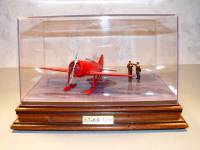
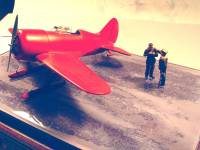 I
always like to display my models with a base and some figures to add interest.
I began with a 1/24th scale diorama plastic case from Testor. These cases provide
a dust cover to protect the model and are available in different sizes. I prepared
the base by first removing the finished ground work and replaced the surface
with a covering simulating ice-covered asphalt. I made this covering by using
a piece of 1/4" clear plastic cut to the size of the base. I then air brushed
a thin mixture of white and gray paint on the backside of the plastic to replicate
the cloudy look of ice. Then I white glued a piece of black/gray construction
paper, to represent the asphalt, to the painted side of the plastic. I then
added this sandwich to the base frame and I was happy with the results. I then
trimmed the base with wood picture frame molding and set the completed base
on to the frame.
I
always like to display my models with a base and some figures to add interest.
I began with a 1/24th scale diorama plastic case from Testor. These cases provide
a dust cover to protect the model and are available in different sizes. I prepared
the base by first removing the finished ground work and replaced the surface
with a covering simulating ice-covered asphalt. I made this covering by using
a piece of 1/4" clear plastic cut to the size of the base. I then air brushed
a thin mixture of white and gray paint on the backside of the plastic to replicate
the cloudy look of ice. Then I white glued a piece of black/gray construction
paper, to represent the asphalt, to the painted side of the plastic. I then
added this sandwich to the base frame and I was happy with the results. I then
trimmed the base with wood picture frame molding and set the completed base
on to the frame.
Next I added two figures represent a pilot and officer discussing the flight of the prototype. The pilot figure is an old metal casting, but I do not remember who produced this fine figure. The officer figure is a modified Russian officer figure from ICM. I painted these figures by first priming them with white paint and base coating all the base colors using various brands of acrylic colors. Once these were dried I then shaded the colors using Winsor & Newton oil paints. I completed the base by adding a brass tag with rub on letters and Russian parade decals from a 1/35th military sheet from SuperScale.
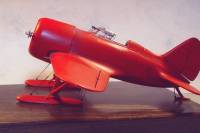 The
completed model and base make up a surprisingly small diorama. The looks of
the TsKB-12bis are definitely Soviet Era Russian. I enjoyed building this little
model and it makes a wonderful addition to my collection. I hope you enjoy the
model and thanks for taking time to read the review. You can contact me at Emilio.Diaz@ispat.com
if you have any questions or comments.
The
completed model and base make up a surprisingly small diorama. The looks of
the TsKB-12bis are definitely Soviet Era Russian. I enjoyed building this little
model and it makes a wonderful addition to my collection. I hope you enjoy the
model and thanks for taking time to read the review. You can contact me at Emilio.Diaz@ispat.com
if you have any questions or comments.
Polikarpov's I-16 Fighter, It's Forerunners and Progeny, by Yefim Gordon and
Kevin Dexter
Les avions de Chasse Polikarpov, by Herbert Leonard
Soviet Air force Fighter Colors 1941-1945, by Erik Pilawskii
Koku-Fan, March 1986, Modeling Manual on the I-16
Polkarpov Fighters in Action, Part 2, Aircraft Number 162, by Hans-Heiri Stapfer
Scale Models, August 1979, Vol. 10, No.119, I-16 study by Harry Woodman